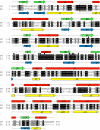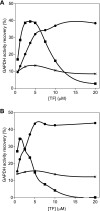Trigger factor from the psychrophilic bacterium Psychrobacter frigidicola is a monomeric chaperone
- PMID: 19060145
- PMCID: PMC2632001
- DOI: 10.1128/JB.01137-08
Trigger factor from the psychrophilic bacterium Psychrobacter frigidicola is a monomeric chaperone
Abstract
In eubacteria, trigger factor (TF) is the first chaperone to interact with newly synthesized polypeptides and assist their folding as they emerge from the ribosome. We report the first characterization of a TF from a psychrophilic organism. TF from Psychrobacter frigidicola (TF(Pf)) was cloned, produced in Escherichia coli, and purified. Strikingly, cross-linking and fluorescence anisotropy analyses revealed it to exist in solution as a monomer, unlike the well-characterized, dimeric E. coli TF (TF(Ec)). Moreover, TF(Pf) did not exhibit the downturn in reactivation of unfolded GAPDH (glyceraldehyde-3-phosphate dehydrogenase) that is observed with its E. coli counterpart, even at high TF/GAPDH molar ratios and revealed dramatically reduced retardation of membrane translocation by a model recombinant protein compared to the E. coli chaperone. TF(Pf) was also significantly more effective than TF(Ec) at increasing the yield of soluble and functional recombinant protein in a cell-free protein synthesis system, indicating that it is not dependent on downstream systems for its chaperoning activity. We propose that TF(Pf) differs from TF(Ec) in its quaternary structure and chaperone activity, and we discuss the potential significance of these differences in its native environment.
Figures







Similar articles
-
SAXS data based global shape analysis of trigger factor (TF) proteins from E. coli, V. cholerae, and P. frigidicola: resolving the debate on the nature of monomeric and dimeric forms.J Phys Chem B. 2015 May 21;119(20):6101-12. doi: 10.1021/acs.jpcb.5b00759. Epub 2015 May 7. J Phys Chem B. 2015. PMID: 25950744
-
Dimeric trigger factor stably binds folding-competent intermediates and cooperates with the DnaK-DnaJ-GrpE chaperone system to allow refolding.J Biol Chem. 2005 Apr 8;280(14):13315-20. doi: 10.1074/jbc.M414151200. Epub 2005 Jan 4. J Biol Chem. 2005. PMID: 15632130
-
PPIase domain of trigger factor acts as auxiliary chaperone site to assist the folding of protein substrates bound to the crevice of trigger factor.Int J Biochem Cell Biol. 2010 Jun;42(6):890-901. doi: 10.1016/j.biocel.2010.01.019. Epub 2010 Jan 21. Int J Biochem Cell Biol. 2010. PMID: 20096367
-
Microbial molecular chaperones.Adv Microb Physiol. 2001;44:93-140. doi: 10.1016/s0065-2911(01)44012-4. Adv Microb Physiol. 2001. PMID: 11407116 Review.
-
Toward understanding life under subzero conditions: the significance of exploring psychrophilic "cold-shock" proteins.Astrobiology. 2012 Nov;12(11):1078-86. doi: 10.1089/ast.2012.0858. Epub 2012 Oct 19. Astrobiology. 2012. PMID: 23082745 Review.
Cited by
-
The selective roles of chaperone systems on over-expression of human-like collagen in recombinant Escherichia coli.J Ind Microbiol Biotechnol. 2014 Nov;41(11):1667-75. doi: 10.1007/s10295-014-1500-x. Epub 2014 Aug 29. J Ind Microbiol Biotechnol. 2014. PMID: 25168680
-
Comparative Proteomic Analysis of Psychrophilic vs. Mesophilic Bacterial Species Reveals Different Strategies to Achieve Temperature Adaptation.Front Microbiol. 2022 May 3;13:841359. doi: 10.3389/fmicb.2022.841359. eCollection 2022. Front Microbiol. 2022. PMID: 35591995 Free PMC article.
-
Helping proteins come in from the cold: 5 burning questions about cold-active enzymes.BBA Adv. 2023 Nov 27;5:100104. doi: 10.1016/j.bbadva.2023.100104. eCollection 2024. BBA Adv. 2023. PMID: 38162634 Free PMC article. Review.
-
The expression and characterization of recombinant cp19k barnacle cement protein from Pollicipes pollicipes.Philos Trans R Soc Lond B Biol Sci. 2019 Oct 28;374(1784):20190205. doi: 10.1098/rstb.2019.0205. Epub 2019 Sep 9. Philos Trans R Soc Lond B Biol Sci. 2019. PMID: 31495308 Free PMC article.
-
Novel functions of peroxiredoxin Q from Deinococcus radiodurans R1 as a peroxidase and a molecular chaperone.FEBS Lett. 2019 Jan;593(2):219-229. doi: 10.1002/1873-3468.13302. Epub 2018 Dec 11. FEBS Lett. 2019. PMID: 30488429 Free PMC article.
References
-
- Cai, H., C. C. Wang, and C. L. Tsou. 1994. Chaperone-like activity of protein disulfide isomerase in the refolding of a protein with no disulfide bonds. J. Biol. Chem. 26924550-24552. - PubMed
-
- Chauvin, F., L. Brand, and S. Roseman. 1994. Sugar transport by the bacterial phosphotransferase system: characterization of the Escherichia coli enzyme I monomer/dimer transition kinetics by fluorescence anisotropy. J. Biol. Chem. 26920270-20274. - PubMed
-
- Chen, J., J. L. Song, S. Zhang, Y. Wang, D. F. Cui, and C. C. Wang. 1999. Chaperone activity of DsbC. J. Biol. Chem. 27419601-19605. - PubMed
-
- Ferrer, M., H. Lunsdorf, T. N. Chernikova, M. Yakimov, K. N. Timmis, and P. N. Golyshin. 2004. Functional consequences of single:double ring transitions in chaperonins: life in the cold. Mol. Microbiol. 53167-182. - PubMed
Publication types
MeSH terms
Substances
LinkOut - more resources
Full Text Sources
Other Literature Sources
Molecular Biology Databases
Research Materials
Miscellaneous

